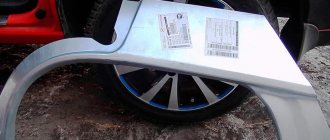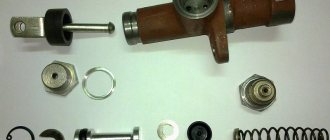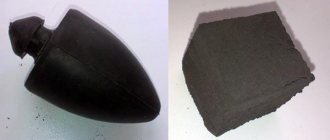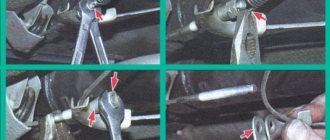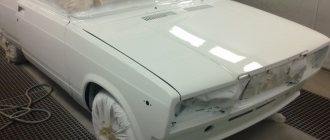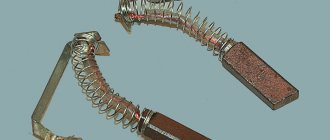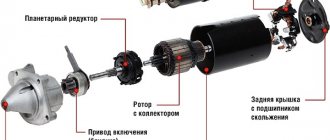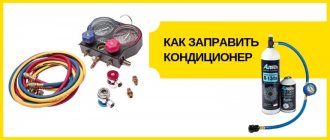The design of a car tire is quite complex. Even a beginner can handle tire puncture repair in the tread area. A side cut of the tire is a more complex damage. Not every car service center will undertake the repair of a side cut. So is it worth spending energy, time and money on repairs? And how to repair a wheel with your own hands?
Is it possible to repair a side cut of a tire?
Only the lazy did not talk about the quality of roads It is not surprising that under such conditions punctures and cuts to car tires very often occur.
But a cut on the side surface of the tire does not occur so often, because it requires very “extreme” conditions to occur. There are also “wars” for parking, when neighbors, not dividing a parking space, cut the tires of the “offender”. What to do in such a situation?
Of course, you will have to replace the cut tire. But there is a way to restore it using special patches. This method will help out if you don’t have a spare tire at hand, and it’s a long way to get to the workshop.
But we must understand that this measure is temporary, because it is dangerous to fully operate such a wheel.
How does a tire work?
The design of a modern tire is a rather complex system, within which there are two types of strength frame:
- Metal frame - made of the finest metal wire threads;
- Frame made of durable nylon threads.
There are 2 types of car tire products:
- radial - the cord threads do not intersect, they are located transversely from one side to the other;
- diagonal - cord threads are located diagonally from one side to the other, crossing in layers.
Currently, radial ones are being mass produced, and diagonal ones are fading into the background.
During the production of tires, the power frame made of metal and nylon is filled with a layer of rubber, which gives strength to the structure. The cord made of wire and threads is firmly held by a rubber layer, and the wheel can withstand heavy loads without bursting.
Why is a tire cut dangerous?
When cut on the side, the wires and cords are torn or cut, and the strength of the entire wheel is lost. Even when the cut is sealed, these threads are not restored. And any obstacle in the form of a hole or curb can lead to dire consequences. The wheel will simply burst from the load and the car will lose control.
A side puncture is not so dangerous, and after a quality repair it is quite possible to use such a wheel.
Why do cracks appear?
Every motorist must know why the tires on his car suddenly crack and what leads to such a situation.
There are several potential reasons. They can manifest themselves singly or act as a merger of several factors simultaneously.
- Low quality tires. One of the main reasons why even new tires often crack on a car. Therefore, motorists are advised not to skimp on tires, but also to buy kits in trusted places. The production date also plays an important role. It is not recommended to take tires that are heavily stored in warehouses. They are unlikely to withstand the entire declared service life.
- Age. Tires can also crack due to natural causes such as aging. This applies not only to the storage of new tires, but also to the long-term use of rubber. The influence of factors such as snow, rain and extreme heat contribute to the destruction of the rubber structure, and corresponding marks appear on its surfaces.
- Violation of storage rules. There are certain recommendations and regulations according to which seasonal tires should be stored. When removing one set and installing a second one on the car, winter or summer tires should be stored correctly and provided with appropriate conditions for subsequent long-term storage.
- Failure to comply with operating rules. The most common example is using summer tires in winter and winter tires in summer. Tires are designed to operate at certain temperatures. If this rule is violated, the rubber is actively destroyed.
- Incorrect installation. The phenomenon is rare, but it cannot be excluded. During installation, the tire cords can stretch or even tear. Therefore, when changing shoes on a car, it is better to choose proven tire services.
As you can see, there is nothing supernatural here. The reasons are quite banal and obvious. But even this does not solve the problem of cracking. Many motorists stubbornly continue to violate all rules and recommendations. Hence the corresponding consequences.
What kind of cut can be repaired?
Not every cut on the side of a tire can be repaired. Repairable types of cuts:
- A cut along the frame threads, if it does not exceed 5 centimeters.
- A cut across the frame threads, if it is more than 3 centimeters.
Tires with a cut located less than 4 cm from the edge cannot be rebuilt or used.
For truck tires, the requirements are more stringent - if more than 10 cords are damaged, the tire is not repaired but sent to scrap.
Are tires repairable?
Particularly thrifty drivers, who are trying to save every penny and not spend extra money on their car, are interested in whether it is possible to restore tires if cracks form on them.
The answer to this question again depends on the specific circumstances.
There are masters who are ready to do whatever the client asks for money. At the same time, they are silent about the consequences that such repairs can lead to.
You should figure out what to do in such a situation and how you can treat your tires so that they do not crack further. It is worth giving several recommendations in this regard.
- It is almost impossible to remove deep damage. Yes, it is possible to remove defects cosmetically. But since the cracks are deep enough and can reach the cord, no adequate craftsman will undertake such work. He will not take responsibility for what will happen to the car and its driver if he again drives on retreaded tires.
- If the damage is minor, then repairs are allowed. To remove cracks, you will need to contact a tire shop. Here, using a special machine, defects will be repaired by melting rubber. But no one will give guarantees for long-term work after such a restoration. Therefore, everything here is completely under your responsibility and at your own discretion.
- When we are talking about small cracks and cobwebs that have not yet had time to disrupt the structure of the rubber itself, you should use special compounds. This is a silicone-based liquid or spray. They are positioned as a means to slow down the aging of rubber. They work pretty well. But it is better to use them even before the first cracks appear, purely for prevention and to extend the service life of the rubber set.
Tire side cut repair
A cut on the side of a tubeless tire is much more difficult to repair than a regular puncture. The reason lies in the fact that the side surface of the wheel is more subject to loads and deformations due to the smaller thickness of the material. This is most noticeable on low-quality road surfaces.
Tools and materials
To repair tire side cuts yourself, you will need:
- raw rubber;
- fine-grain sandpaper;
- a hair dryer or an old iron with a metal sole;
- alcohol or purified gasoline for degreasing;
- a rubber patch with an adhesive layer, preferably reinforced (with cord threads).
We repair the side cut of the tire with our own hands.
Let's consider the most affordable recovery method. Procedure:
- Sand the edges of the damaged area with sandpaper, giving it a cup shape.
- Degrease the surface with an alcohol solution or purified gasoline.
- Fill the cavity with raw rubber and vulcanize it using a hair dryer or iron. The surface should become matte.
- Sand the patch area with sandpaper.
- Glue the patch on.
- Balance the wheel.
A tire restored in this way is not intended for use in difficult conditions. It is also not recommended to use it constantly. The best option is to use it as a spare tire.
If your tire has a side puncture, then after repair you can safely continue to use it.
Repair at a service station
The service station performs more complex and high-quality repairs. The sequence of work looks like this:
- Dismantle the wheel and assess the extent of damage.
- Level the edge of the damaged area using side cutters.
- Clean the surface and apply a special cement mixture.
- Raw rubber is cut into narrow strips, stretched and placed into the cut cavity.
- Rubber is vulcanized using special equipment.
- Clean the damaged area, degrease it and apply cement.
- After the cement has dried, glue the patch and treat its edges with sealant.
- Install the tire on the rim and balance the wheel using special equipment.
Do not subject the repaired tire to heavy loads - this can be dangerous. Use it in an emergency or as a spare tire to get you to the tire store or repair shop.
How to determine if a tire can be repaired
To reliably assess the consequences of tire deformation, before repairing the tire, contact a specialized center. The technicians will figure out whether it is possible to continue driving the car or whether it is worth replacing the tires. The main inspection criterion is the width of the seam that needs to be repaired. It is worth considering that it is dangerous to seal holes wider than 40 mm with rubber compounds.
If the craftsmen decide to restore the tire and make a patch, then the restoration process includes the following stages:
- dismantling a tire - before sealing the holes, specialists measure the diameter of the seam;
- trimming and grinding the edges of the hole - high-quality replacement of the blade requires reliable welding of the material;
- applying cementitious material and raw rubber, which allows you to make a reliable patch;
- vulcanization of the tire in a professional chamber, which allows you to reliably seal the rubber;
- applying a reinforced patch to the treated area;
- degreasing the surface and re-applying the cementitious composition;
- tire installation.
The decision to make a patch should be made by experienced specialists who can advise whether it is worth sealing the seam or whether it is necessary to replace the tires. Restoration of rubber, despite the observance of technology, cannot restore the original properties of the frame, so you should ride on such tires carefully.
It is also worth considering that if you are restoring a tire, you must break it in before active use. To avoid negative consequences, we do not recommend driving at high speeds.
Disadvantages of Tire Side Cut Repair
A tire damaged in this way must be replaced. But in extreme situations, it is possible to use a repaired tire with a patch. The main thing is to remember that loads are detrimental to such a wheel. This creates a danger for all road users. Let's look at the negative consequences of repairs:
- The wheel loses balance, which is difficult to compensate even by balancing with weights. An imbalance causes steering control to deteriorate.
- This recovery method is unreliable. The patch becomes deformed under high loads and begins to peel off over time. The tire retains pressure less well and has to be inflated frequently.
- The repaired side cut of the wheel is a time bomb. At any moment, such a tire can burst, putting everyone around you in danger.
Repair or replacement? Repairing tire side cuts is not a panacea. Each car owner must decide for himself what to do with a tire damaged on the side. It is necessary to take into account all the risks; if you decide to use it, we advise you to do so exclusively as a spare tire.
The cord on the tire is worn out, what should I do?
During the operation of a car, its wheels receive various damages - side cuts appear on the tires, tire deformation (the so-called hernia).
- 1 Causes of hernia on the wheel
- 2 Is it possible to drive with a hernia on a wheel?
- 3 What to do if there is a hernia on the wheel
- 4 How professional tire fitters fix a hernia
- 5 Rules for driver behavior when a hernia is detected on a wheel
- 6 Wheel selection
Motorists often ask if there is a lump on the wheel, what to do, and whether it is possible to operate the car with it. In this article we will try to deal with this issue, and at the same time we will advise how to eliminate the defect.
Causes of hernia on the wheel
A bump on the side surface of a tire is formed as a result of the destruction of the inner cord; automobile rubber itself is multilayer. A hernia (bump) on a tire can form for various reasons; the cord threads usually break:
- with a side cut of the tire;
- when a car falls into a deep road hole, when the vehicle is moving at a sufficiently high speed;
- as a result of abrasion of the tread, for example, on a curb;
- from a blow to the wheel, for example, when a car gets into an accident.
Is it possible to drive with a hernia on a wheel?
When the cord on a tire is damaged by an impact, the threads inside break and a bump appears on the wheel. Usually the lump on the wheel comes out from the side; it mainly forms on the outside. A hernia comes in different sizes, and if it is small, it may not even be noticed at first. If a bump has appeared on a car tire and increased in size, when the car is moving, a beating may be felt, which can be felt in the steering wheel.
Is it possible to drive with a bump on the wheel? It all depends on the size of the damage, but if you approach this issue strictly, it is extremely undesirable to operate a car with damaged tires, even if the defect is minor. The thing is that during the operation of the vehicle, the damaged area on the wheel progresses and increases in size, and in some cases the tire may explode, and the driver may get into an emergency. A tire with a lateral hernia bursts in the following cases:
- if the damaged wheel gets into the hole again;
- at high speed when driving on uneven roads;
- on a loaded car (for example, there are several passengers in the cabin and there is a heavy load in the trunk);
- at high speed;
- when you press the brake pedal sharply.
Manufacturers of car tires warn that the use of tires with any damage is prohibited, regardless of the degree of the defect.
The driver can feel the appearance of a bump on the tire by the first signs - there may not be an imbalance, but barely noticeable bumps begin to appear in the wheel, and the ride becomes uncomfortable. If the car owner nevertheless decides to continue to operate the car, he must regularly check the condition of the wheel and carry out an external inspection.
What to do if there is a hernia on the wheel
When a defect appears on a car tire in the form of a bump, theoretically the driver has three options:
- completely replace the wheel (install a spare tire);
- go to a tire repair shop to have the defect repaired;
- try to repair the tire yourself.
The third option is only theoretically possible, and then only if the driver himself is almost a professional tire fitter. The most reliable option is to change the entire wheel or install a new tire on the rim.
How professional tire fitters fix a hernia
Repairing a tire in a tire shop looks something like this:
- the wheel is removed and disassembled;
- the surface of the tire is thoroughly cleaned and degreased;
- a layer of material containing raw rubber is applied to the damaged area;
- a reinforced patch is installed on top of the damage;
- vulcanize the tire.
It is possible to remove a bump on a tire in this way, but it should be taken into account that the inner cord is still not completely restored, and the repaired area on the tire remains the most vulnerable spot. After repairing a tire, it must be balanced, but if the wheel cannot be balanced, it has to be scrapped.
To restore a tire using a vulcanizer, it must be left in a tire shop for a day, which is very inconvenient for the driver. Even when restoring a wheel with a hernia, you should take into account that such repairs are quite expensive, and in some cases they are comparable to the price of a new tire. You can understand the car owner - sometimes a hernia appears on almost new tires, and the driver regrets the money spent on the purchase. But road safety is no joke - it’s better to lose money than a car, your health or even your life.
